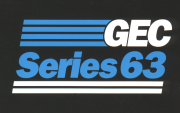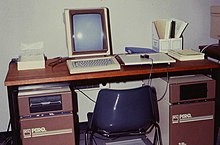A control store is the part of a CPU's control unit that stores the CPU's microprogram. It is usually accessed by a microsequencer. A control store implementation whose contents are unalterable is known as a Read Only Memory (ROM) or Read Only Storage (ROS); one whose contents are alterable is known as a Writable Control Store (WCS).

The PDP–11 is a series of 16-bit minicomputers sold by Digital Equipment Corporation (DEC) from 1970 into the late 1990s, one of a set of products in the Programmed Data Processor (PDP) series. In total, around 600,000 PDP-11s of all models were sold, making it one of DEC's most successful product lines. The PDP-11 is considered by some experts to be the most popular minicomputer.
Symbolics, Inc., was a privately held American computer manufacturer that acquired the assets of the former company and continues to sell and maintain the Open Genera Lisp system and the Macsyma computer algebra system.

A workstation is a special computer designed for technical or scientific applications. Intended primarily to be used by a single user, they are commonly connected to a local area network and run multi-user operating systems. The term workstation has been used loosely to refer to everything from a mainframe computer terminal to a PC connected to a network, but the most common form refers to the class of hardware offered by several current and defunct companies such as Sun Microsystems, Silicon Graphics, Apollo Computer, DEC, HP, NeXT, and IBM which powered the 3D computer graphics revolution of the late 1990s.

The Xerox Alto is a computer that was designed from its inception to support an operating system based on a graphical user interface (GUI), later using the desktop metaphor. The first machines were introduced on 1 March 1973, a decade before mass-market GUI machines became available.
Apollo/Domain is a series of workstations that were developed and produced by Apollo Computer from c. 1980 to 1989. The machines were built around the Motorola 68k series of processors, except for the DN10000, which has from one to four of Apollo's RISC processors, named PRISM.
Pyramid Technology Corporation was a computer company that produced a number of RISC-based minicomputers at the upper end of the performance range. It was based in the San Francisco Bay Area of California

The DECstation was a brand of computers used by DEC, and refers to three distinct lines of computer systems—the first released in 1978 as a word processing system, and the latter two both released in 1989. These comprised a range of computer workstations based on the MIPS architecture and a range of PC compatibles. The MIPS-based workstations ran ULTRIX, a DEC-proprietary version of UNIX, and early releases of OSF/1.

RISC iX is a discontinued Unix operating system designed to run on a series of workstations based on the Acorn Archimedes microcomputer. Heavily based on 4.3BSD, it was initially completed in 1988, a year after Arthur but before RISC OS. It was introduced in the ARM2-based R140 workstation in 1989, followed up by the ARM3-based R200-series workstations in 1990.

The Sun-2 series of UNIX workstations and servers was launched by Sun Microsystems in November 1983. As the name suggests, the Sun-2 represented the second generation of Sun systems, superseding the original Sun-1 series. The Sun-2 series used a 10 MHz Motorola 68010 microprocessor with a proprietary Sun-2 Memory Management Unit (MMU), which enabled it to be the first Sun architecture to run a full virtual memory UNIX implementation, SunOS 1.0, based on 4.1BSD. Early Sun-2 models were based on the Intel Multibus architecture, with later models using VMEbus, which continued to be used in the successor Sun-3 and Sun-4 families.

Sun-1 was the first generation of UNIX computer workstations and servers produced by Sun Microsystems, launched in May 1982. These were based on a CPU board designed by Andy Bechtolsheim while he was a graduate student at Stanford University and funded by DARPA. The Sun-1 systems ran SunOS 0.9, a port of UniSoft's UniPlus V7 port of Seventh Edition UNIX to the Motorola 68000 microprocessor, with no window system. Affixed to the case of early Sun-1 workstations and servers is a red bas relief emblem with the word SUN spelled using only symbols shaped like the letter U. This is the original Sun logo, rather than the more familiar purple diamond shape used later.

The Sun386i is a discontinued hybrid UNIX workstation/PC compatible computer system produced by Sun Microsystems, launched in 1988. It is based on the Intel 80386 microprocessor but shares many features with the contemporary Sun-3 series systems.
Spice Lisp is a programming language, a dialect of Lisp. Its implementation, originally written by Carnegie Mellon University's (CMU) Spice Lisp Group, targeted the microcode of the 16-bit workstation PERQ, and its operating system Accent. It used that workstation's microcode abilities to implement a stack machine architecture to store its data structures as 32-bit objects and to enable run time type-checking. It would later be popular on other workstations.
Joel McCormack is an American computer scientist who designed the NCR Corporation version of the p-code machine, which is a kind of stack machine popular in the 1970s as the preferred way to implement new computing architectures and languages such as Pascal and BCPL. The NCR design shares no common architecture with the Pascal MicroEngine designed by Western Digital but both were meant to execute the UCSD p-System.[1,2]

The GEC Series 63 was a 32-bit minicomputer produced by GEC Computers Limited of the UK during the 1980s in conjunction with A. B. Dick in USA. During development, the computer was known as the R Project. The hardware development was done in Scottsdale, Arizona whilst the software was the responsibility of GEC in Dunstable, UK. The hardware made early use of pipeline concepts, processing one instruction whilst completing the preceding one.
The Torch Triple X was a UNIX workstation computer produced by the British company Torch Computers, and launched in 1985. It was based on the Motorola 68010 microprocessor and ran a version of UNIX System V.

Whitechapel Computer Works Ltd. (WCW) was a computer workstation company founded in the East End of London, United Kingdom in April 1983 by Timothy Eccles and Bob Newman, with a combined investment of £1 million from the Greater London Enterprise Board, venture capital companies Newmarket and Baillie Gifford, and the Department of Trade and Industry. The company was situated in the Whitechapel Technology Centre - a council-funded high-technology enterprise hub - and began the design of their first workstation model in August 1983, shipping the first units by September 1984.
The ICL DRS was a range of departmental computers from International Computers Limited (ICL). Standing originally for Distributed Resource System, the full name was later dropped in favour of the abbreviation.











